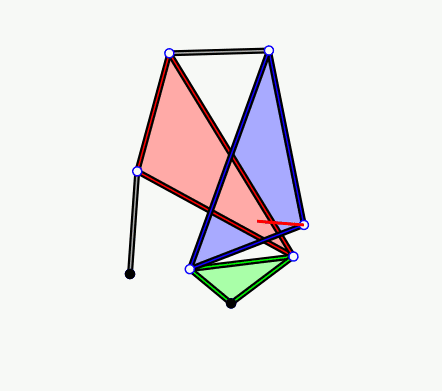Alfred Bray Kempe on:
[Wikipedia]
[Google]
[Amazon]
Sir Alfred Bray Kempe FRS (6 July 1849 – 21 April 1922) was a mathematician best known for his work on linkages and the four colour theorem.
 In 1877 Kempe discovered a new straight line linkage called the
In 1877 Kempe discovered a new straight line linkage called the
How to draw a straight line; a lecture on linkages
, London: Macmillan and Co. *Found at Project Gutenberg: A. B. Kempe (1877
How to draw a straight line; a lecture on linkages, London: Macmillan and Co.
*Examples of Kempe's Universality Theorem
Mechanical computation and algebraic curvesAutomatic generation of Kempe Linkages for Algebraic Curves.
{{DEFAULTSORT:Kempe, Alfred Bray 19th-century English mathematicians 20th-century English mathematicians 1849 births 1922 deaths Graph theorists Fellows of the Royal Society Alumni of Trinity College, Cambridge English mountain climbers
Biography
Kempe was the son of the Rector of St James's Church, Piccadilly, the Rev. John Edward Kempe. He was educated at St Paul's School, London and then studied at Trinity College, Cambridge, whereArthur Cayley
Arthur Cayley (; 16 August 1821 – 26 January 1895) was a prolific United Kingdom of Great Britain and Ireland, British mathematician who worked mostly on algebra. He helped found the modern British school of pure mathematics.
As a child, C ...
was one of his teachers. He graduated BA (22nd wrangler) in 1872. Despite his interest in mathematics he became a barrister
A barrister is a type of lawyer in common law jurisdictions. Barristers mostly specialise in courtroom advocacy and litigation. Their tasks include taking cases in superior courts and tribunals, drafting legal pleadings, researching law and ...
, specialising in the ecclesiastical law. He was knighted in 1913, the same year he became the Chancellor
Chancellor ( la, cancellarius) is a title of various official positions in the governments of many nations. The original chancellors were the of Roman courts of justice—ushers, who sat at the or lattice work screens of a basilica or law cou ...
for the Diocese of London
The Diocese of London forms part of the Church of England's Province of Canterbury in England.
It lies directly north of the Thames. For centuries the diocese covered a vast tract and bordered the dioceses of Norwich and Lincoln to the north ...
. He was also Chancellor of the dioceses of Newcastle, Southwell, St Albans, Peterborough, Chichester, and Chelmsford. He received the honorary degree DCL
DCL or may refer to:
* 650 in Roman numerals, see 650 (disambiguation)
Computers
* Data Center Linux, see Open Source Development Labs
* Data Control Language, a subset of SQL
* Dialog Control Language, a language and interpreter within AutoC ...
from the University of Durham and he was elected a Bencher of the Inner Temple in 1909.
In 1876 he published his article ''On a General Method of describing Plane Curves of the nth degree by Linkwork,'' which presented a procedure for constructing a linkage that traces an arbitrary algebraic plane curve. This was a remarkable generalization of his work on the design of linkages to trace straight lines. This direct connection between linkages and algebraic curves is now called Kempe's universality theorem In 1876 Alfred B. Kempe published his article ''On a General Method of describing Plane Curves of the nth degree by Linkwork,'' which showed that for an arbitrary algebraic plane curve a linkage can be constructed that draws the curve. This direct ...
. While Kempe's proof was flawed, the first complete proof was provided in 2002, based on his ideas.
 In 1877 Kempe discovered a new straight line linkage called the
In 1877 Kempe discovered a new straight line linkage called the Quadruplanar inversor
The Quadruplanar inversor of Sylvester and Kempe is a generalization of Hart's inversor. Like Hart's inversor, is a mechanism that provides a perfect straight line motion without sliding guides.
The mechanism was described in 1875 by James Josep ...
or ''Sylvester–Kempe Inversor'' and published his influential lectures on the subject. In 1879 Kempe wrote his famous "proof" of the four colour theorem, shown incorrect by Percy Heawood in 1890. Much later, his work led to fundamental concepts such as the Kempe chain and unavoidable sets.
Kempe (1886) revealed a rather marked philosophical bent, and much influenced Charles Sanders Peirce. Kempe also discovered what are now called multisets, although this fact was not noted until long after his death.Ivor Grattan-Guinness
Ivor Owen Grattan-Guinness (23 June 1941 – 12 December 2014) was a historian of mathematics and logic.
Life
Grattan-Guinness was born in Bakewell, England; his father was a mathematics teacher and educational administrator. He gained his bac ...
(2000) ''The Search for Mathematical Roots 1870–1940''. Princeton Univ. Press
Kempe was elected a fellow of the Royal Society in 1881. He was Treasurer and Vice-President of the Royal Society 1899–1919. He was a president of the London Mathematical Society
The London Mathematical Society (LMS) is one of the United Kingdom's learned societies for mathematics (the others being the Royal Statistical Society (RSS), the Institute of Mathematics and its Applications (IMA), the Edinburgh Mathematical S ...
from 1892 to 1894. He was also a mountain climber, mostly in Switzerland.
His first wife was Mary, daughter of Sir William Bowman, 1st Baronet; she died in 1893. He then married, in 1897, Ida, daughter of Judge Meadows White, QC. He had two sons and one daughter.
References
External links
* * *From the Cornell University archives: A. B. Kempe (1877How to draw a straight line; a lecture on linkages
, London: Macmillan and Co. *Found at Project Gutenberg: A. B. Kempe (1877
How to draw a straight line; a lecture on linkages, London: Macmillan and Co.
*Examples of Kempe's Universality Theorem
Mechanical computation and algebraic curves
{{DEFAULTSORT:Kempe, Alfred Bray 19th-century English mathematicians 20th-century English mathematicians 1849 births 1922 deaths Graph theorists Fellows of the Royal Society Alumni of Trinity College, Cambridge English mountain climbers